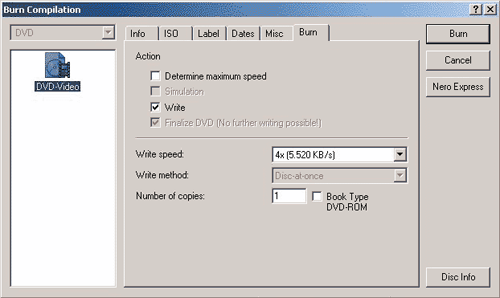Spring 2004 DVD Performance Roundup: More DVD Dual 8X
by Kristopher Kubicki on April 28, 2004 7:00 AM EST- Posted in
- Storage
Bitsetting and Calibration
We have not touched very much on bit setting over the last few DVD reviews. For those of you who do not know what it is, let us go over it quickly.Whenever we play a DVD in a DVD drive (stand alone or PC based), the player queries the disc for what "type" of media it is. Typically, a DVD identifies itself as a "DVD-ROM". Unfrotunately, DVD+R and DVD+RW discs commonly identify themselves as "DVD+R" and "DVD+RW". Whether intentionally or just through lack of foresight, some DVD players do not understand any identifiers other than "DVD-ROM". This commonly affects only much older players and does not particularly affect many DVD players now.
With the problem of compatibility between this miniscule difference in discs, some DVD manufacturers released third party tools to allow the end user to select which kind of DVD booktype the drive should use. This process is also known as bitsetting, since the difference between a "DVD+R" and "DVD-ROM" identifier is literally one bit. Unfortunately, many very common drives (such as the NEC 2500A and the Plextor 708A) do not have official sanctioned firmwares that allow such practice. However, there is an excellent underground community that has worked very hard to modify manufacturers official firmwares for this support. When all goes well, the ability to bitset appears in Nero during the burn process.
There is another important aspect of firmware modification that we have not touched on, and that is write strategy. In very simple terms, the firmware contains a list of hundreds of media types (such as MCC 002), and at what speed/mode the drive should burn that media. This is called a write strategy.
When looking at our burn processes from the burners in our recent roundup, it seems as though our drives are regressing in terms of speed. The Plextor 708A and NuTech DDW-081 would burn 8X speeds on 4X (and sometimes 2X!) media all the time. Sony's DRU-530A and AOpen's DDW8800 appear much more picky with the media at which they will actually burn 8X. Just like the bitsetting community, there is an even larger community of programmers who actively modify write strategies within firmwares to increase speed on common media.
Although we did not install any of these third-party firmwares for our roundup, it should be noted that when you buy a drive, increased speeds and booktype options may exist, but you have to travel to the fringe of tech support to get them. Installing these modified firmwares will certainly void your warranty. Consider these options similar to overclocking, but for your DVD burner (there are multiple hacks to get your NuTech DDW-082 to burn at 10X).











24 Comments
View All Comments
rlrus - Tuesday, May 4, 2004 - link
Nu has posted the official firmware upgrade B373, I hope this one is as good or better than the unofficial B372. I bought this drive and hope I have as good results as Anand Tech. With it's ability to write 8 times on 4 times Media and it's speed and error rate being almost as good as the more expensive drives it seemed a bargain.mcveigh - Sunday, May 2, 2004 - link
21:the Nu models do as well or better than everyone else and at the lowest price point.
why shouldn't they win?
KristopherKubicki - Saturday, May 1, 2004 - link
Jeff7181: I think there is a way to get it to scale proper. I will do that for the next review.Kristopher
QuaiBoy - Friday, April 30, 2004 - link
Seems to me that all of the DVD writer reviews lately on Anandtech seem to favor the Nutech product. I don't see a reason from these results to pick that drive over any of the others. There's nothing that makes it anything special, and it certainly doesn't deserve an award over the other drives.Another vote for total write times and for not claiming that all drives with the same chipset will perform similarly. Too many variables. At least test with more media types, like TY and Optodisc. Cheapies like Princo appeal to many as well.
-Evan-
Jeff7181 - Friday, April 30, 2004 - link
The Write Quality graphs are very misleading/hard to read since they are all on different scales... makes on look like crap until you realize you're looking at a 0 - 10 scale rather than 0 - 70. Anything you can do about that or are you just stuck displaying what the crappy software showed you?KristopherKubicki - Thursday, April 29, 2004 - link
This was all commented on in the article. The 708A and the 2500A also use radically different pickups and servos. But then again, i never claimed those two were similar in the review either.Belzer: most of those drives i pointed out were clearly rebadges.
Kristopher
CrazeeHorse - Thursday, April 29, 2004 - link
Belzer,yes. Maybe I should have rephrased my statement, as MAXIMUM burning speed. Yep, it also depends on the burn strategy employed.CrazeeHorse - Thursday, April 29, 2004 - link
Belzer,yes. Maybe I should have rephrased my statement, as MAXIMUM burning speed. Yep, it also depends on the burn strategy employed.CrazeeHorse - Thursday, April 29, 2004 - link
Belzer - Thursday, April 29, 2004 - link
"If you mean burn speed, of course it will be similar in different drives that use the same chipset, as their burn speeds are defined by the chipset!"Uhm, no! Burn speed also depends very much on the write strategies implemented in the firmware. For example NEC ND-2500A and Pioneer DVR-A07 use the same chipset. The NEC uses a 4x-6x-8x Z-CLV technique for 8x burns, the Pioneer uses a 6x-8x Z-CLV technique and is faster.
Drives with the same chipset can have very different properties, only complete rebadged drives will have the same properties.